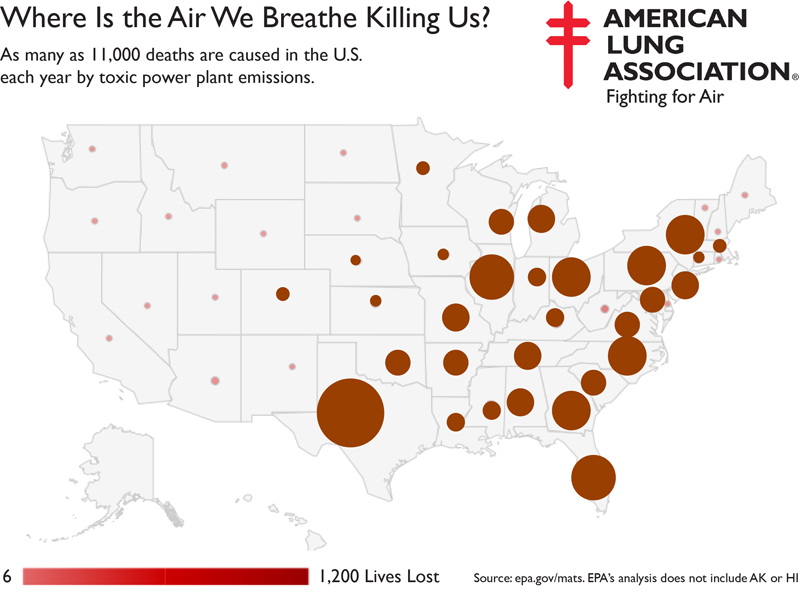You might have read recently about the Environmental Protection Agency’s new limits on carbon pollution from power plants announced this week. In a nutshell, the new rule, issued under the Clean Air Act’s New Source Performance Standards (NSPS) program, requires that new power plants emit no more than 1,000 pounds of CO2 per megawatt hour (MWh). Currently, natural gas plants come in below that, in the 800s, while coal plants emit an average of almost 1,800.
 Take a look at this map from the American Lung Association and you’ll see why this is important. The map shows U.S. deaths caused by toxic power plant emissions. If you live in a state with a big red circle, you should be very very glad about the new rule. Note the big red circle over New Jersey.
Take a look at this map from the American Lung Association and you’ll see why this is important. The map shows U.S. deaths caused by toxic power plant emissions. If you live in a state with a big red circle, you should be very very glad about the new rule. Note the big red circle over New Jersey.
But, the new rule only improves emissions from new power plants, and in New Jersey, that’s only one piece of the air quality puzzle. There is a critical link between transportation fuel usage and air quality, and in New Jersey, the transportation sector is the largest source of greenhouse gas emissions. Transportation-related energy use accounts for about 40 percent of total statewide greenhouse gas emissions with on-road gasoline consumption representing the majority of those emissions. Furthermore, summer is coming, and along with it, we have to start worrying about those really bad air quality days, when it’s actually not safe to breathe the air — especially for the elderly and children.
So while the EPA can help regulate power plants, we can make a big difference ourselves, too, by changing how we get around and how we use our vehicles. There are a few simple things you can do right away to help improve air quality and protect your health and that of the public:
DO…
- Work from home
- Walk or bike for as many trips as possible
- Carpool or use mass transit
- Refuel your car in the evening
- Plan efficient routes
DON’T…
- Top off your gas tank
- Idle your car
- Use gasoline-powered mowers
One of GMTMA’s primary goals is to reduce congestion and improve air quality in our region. That’s why we have so many programs designed to help do just that. Check out our Commuters page to learn how your commute can reduce your carbon footprint and stress while saving you money, including information on carpooling and vanpooling, bus and train, bicycling and walking and incentives and reward programs available to green commuters. You can register for the Green Commuter Rewards Program, too, or get more information on our Safe Routes to School work that aims to get more kids walking and biking (and reduces air pollution in the vicinity of schools — which is a big problem).
Get started today. We can all do our part to improve the quality of the air we breathe.
